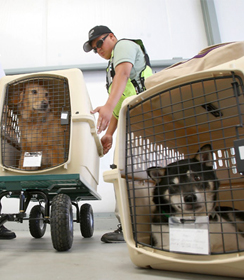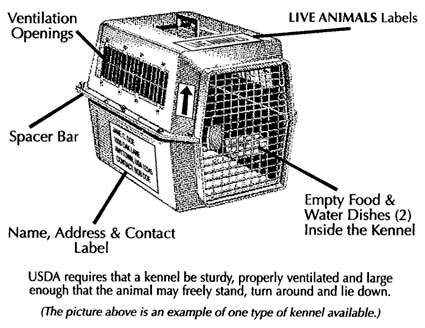
When it comes to pets, it rouses some of the deepest emotions in us. For most of us, pets are as much a part of the family as the children. Albeit they may not be allowed to accompany you on the flight, it is our job to see that your pet gets all the attention and care that they need on its journey. However, all living, warm-blooded animal shipments must meet container requirements established by the USDA. This apart, they must also meet minimum requirements for container construction, stability, and ventilation.
The IATA Live Animal Regulations book contains information for shipping both warm-blooded and cold-blooded live animals. (Details of the regulation can appear as a link since not many browsers would be interested in such details when browsing through this site for the first time).
Dogs and Cats
The Containers used to transport dogs and cats must be:
- Large enough for the animal to sit in a natural position, turn around, and lie down
- Equipped with a securely closing door that operates without any special tools
- Constructed of wood, metal or any material of sufficient strength to withstand normal transportation
- Free from protrusions or any other potentially harmful surface inside
- Well ventilated with openings on at least three sides
- Easy in lifting. Therefore must have handholds
- Leak proof. A solid bottom is a must.
- Roll-free. If the kennel has wheels, the wheels must be removed, retracted, or in some other way be made inoperable in order to prevent rolling
- Constructed to prevent escape of the animal during normal handling
- Padded with suitable absorbent material to ensure cleanliness from litter.
- Constructed to have separate containers for food and water, or one container with separate compartments so that the food and water will not mix together
- Marked with "Live Animal" in letters at least one inch high on the top and one or more sides of the kennel

- One dog or cat, 6 months of age or older
- One puppy or kitten, 8 weeks to 6 months of age, weighing more than 20 pounds each
- Two puppies or kittens, 8 weeks to 6 months of age that are of comparable size, weighing 20 pounds or less each
- Weaned puppies and kittens younger than 8 weeks of age may not be shipped
Most airways will only accept two containers bonded together as one to transport birds.
The container requirements as stated in the IATA Live Animal Regulations book are:
- The finished container may not exceed the size and weight limits for PDQ
- The containers must be fastened together in such a way as to prevent shifting during transport
- All ventilation requirements must be met
- The finished product must fit through the aircraft cargo door without turning or tilting
At end2end Logistics we specialise in providing comprehensive relocation services apart from being professional packers and movers and freight forwarders. We also excel in pet moving and provide free information on customs and baggage rules.